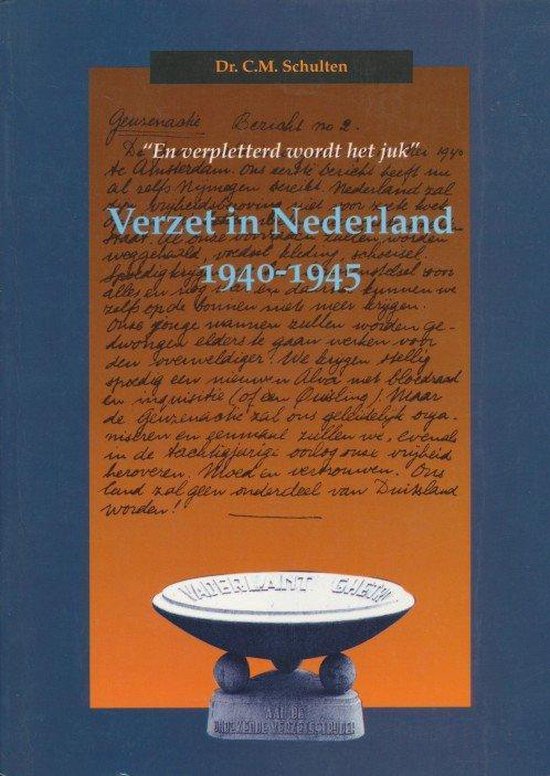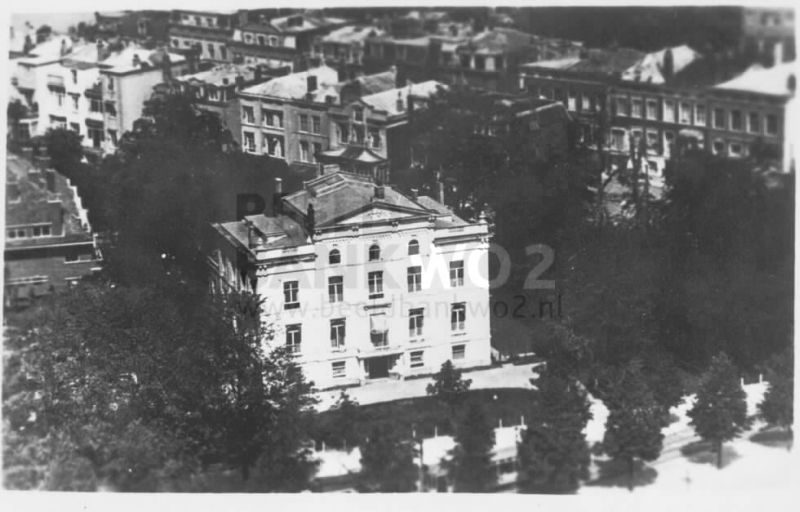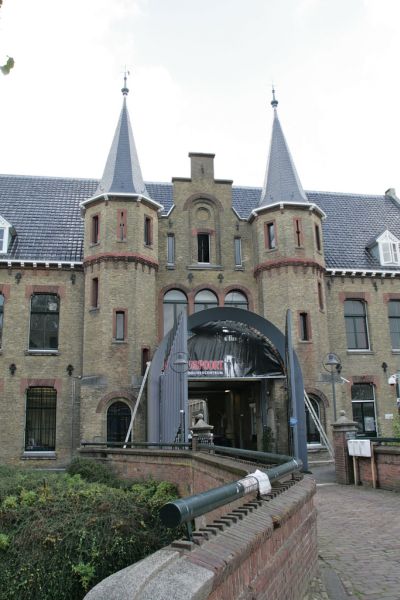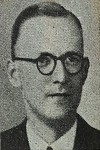Mural Gymnasium Beyers Naudé
The mural in the Gymnasium Beyers Naudé in Leeuwarden was erected in memory of fifteen former students who died during the occupation years as a result of acts of war.
The names of the fifteen victims are:
Jan Dijkstra, Rinze Douma, Hermanus Albertus Feenstra, Willem Gerbrandy, Jan Jacob de Groot, Theodoor Hanselaar, Sijbe J. Hoekstra, Hantje de Jong, Hendrik de Jong, Herman Arend Johannes Mulder, Jacob van der Plaat, Jan Cornelis Veldkamp, Jan Visser , Egbert Mark Wierda and Klaas Jan Wypke Wierda.
Jan Dijkstra was born on December 2, 1919 in Sneek. He was a co-partner of Dijkstra's clay factory. The Sneker sabotage group of the NBS, of which Dijkstra was a member, met on April 9, 1945. When the men left the meeting place on the Oppenhuizerweg near the Houkesloot, they discovered some members of the Grüne Polizei. The resistance fighters fled. When Jan Dijkstra and Jan Willem van der Kouwe jumped into a rowing boat, fire was opened on them. The two fell overboard and swam to the other side of the ditch. When Van der Kouwe crawled out of the water, he was hit in the back by a bullet. He lay wounded on the shore. Dijkstra took cover behind the polder dike. When it was quiet, he crawled to his friend. In the meantime the sentry had been ordered to shoot Dijkstra. The sentry refused, whereupon a member of the Grüne Polizei took the rifle and shot Dijkstra through the lungs. He died on the spot and was buried at the General Cemetery in Sneek. Van der Kouwe was nursed for years, but never fully recovered.
Rinze Douma was born on April 28, 1910 in Bergum. He was a reformed minister in Emmercompascum, where he joined the resistance under the pseudonym 'ds. De Groot' operated. In August 1943 his family moved to Groningen. In this city he distributed illegal newspapers and ensured that people in hiding were given a safe place to stay. He also participated in arms transports. On May 30, 1944, he saw how prisoners were crammed into railway wagons at the Amersfoort station. Douma flew into a rage. When the occupier searched him, illegal papers were found. Via the prisons of Assen and Groningen, Douma was deported to camp Vught on 17 August 1944 and a month later to the Kommando Oraniënburg of the Sachsenhausen concentration camp. On February 4, 1945, Douma was transferred to Bergen-Belsen, where he died of typhoid fever on March 9, 1945.
Hermanus Albertus Feenstra was born on January 20, 1912 in Leeuwarden. The reserve 1st lieutenant of the Jagers regiment was killed on 10 May 1940 in Rotterdam (Waalhaven). He was buried at the General Cemetery in Leeuwarden.
Willem Gerbrandy was born on December 22, 1915 in Goëngamieden. He worked as a volunteer at the secretary of the municipality of Wymbritseradiel. On June 1, 1939, he was assigned to the motor service of the Voluntary Landstorm Corps, dept. Groningen. After the Dutch capitulation on 15 May 1940, Gerbrandy immediately started resistance activities. During an attempt to escape to England, he was arrested near Kijkduin in January 1942 and imprisoned on the death row of the Scheveningen prison. Here he spent six months. He then spent fourteen months in camp Vught. When it was found that he suffered from tuberculosis, Gerbrandy was admitted to the Sint-Jan hospital in Den Bosch. At the request of his family, he was transported to Goënganieden, where he died nine days later, on September 3, 1943, in the parental farm. Gerbrandy was buried in the Reformed cemetery in Goënga.
Jan Jacob de Groot was born on April 12, 1918 in Anjum. On September 26, 1941 he died in an air battle and a subsequent bombing raid on Groningen. De Groot studied at the university of this city. He was buried at the General Cemetery in Veenwouden.
Theodoor Hanselaar was born on November 6, 1918 in Terheide aan Zee. After the Gymnasium in Leeuwarden, he went to a nautical college, where he was trained as a helmsman. To avoid the labor effort, he went into hiding with his girlfriend in Utrecht. During the liberation, on May 7, 1945, Hanselaar went to his parents in Jutphaas. Here he was caught in a firefight and died of his wounds. He was buried in the Oude Kerkveld cemetery in Jutphaas.
Sijbe J. Hoekstra was born on August 14, 1908 in Burum. During the occupation he was a reformed minister in Midwolda, where he did illegal work for the National Support Fund. He was also a member of the Ordedienst. Rev. Hoekstra was shot on April 10, 1945, together with nine other resistance fighters, at the edge of the forest near the Nije Drintse Wei.
Hantje de Jong was born on March 11, 1906 in Hiemert. After his theological studies he became a pastor in Hoek van Holland. In 1941 he left for Rotterdam - Charlois, where he joined the National Organization for help to people in hiding (L.O.) and the Knokploeg. De Jong was arrested on 26 October 1944 because his address had been found during other arrests. He was shot dead on October 28 at the Rotterdam shooting range. Rev. De Jong was buried at the Crooswijk General Cemetery in Rotterdam.
Hendrik de Jong was born on February 11, 1920 in Leeuwarden. The theology student, who lives in Arnhem, was an employee of the L.O. He was also a member of the Trouwgroep. On June 27, 1944, he was arrested during a check on the train. He died on January 11, 1945 in Neuengamme concentration camp.
Herman Arend Johannes Mulder was born on August 15, 1909 in Rotterdam. He was the son of the former rector of the Gereformeerd Gymnasium in Leeuwarden. As a civil servant, Mulder worked as a lawyer in art gallery Kleykamp, opposite the Peace Palace in The Hague, where the card system for labor deployment was housed. The Hague resistance movement often called on Mulder to destroy certain maps from the archive. On April 11, 1944, the building was bombed by the Allies, killing Herman Mulder. He was buried at the Crooswijk General Cemetery in Rotterdam.
Jacob van der Plaat was born on July 17, 1924 in Beetgum. The almost 20-year-old farmer's son was a member of the L.O. He also had contact with a Knokploeg from Meppel through people in hiding in the parental home. In the night of 14 to 15 August 1943, the local office of the municipality of Menaldumadeel was squatted. Van der Place also took part in this action. On the morning of October 20, 1944, he went to the country to bring workers coffee. On the way he was recalled by a platoon of the Grenzschutz of the occupying forces. Jacob did not react and was shot from a great distance and died of his wounds. He was buried at the N.H. cemetery in Beetgum.
Jan Cornelis Veldkamp was born on December 26, 1925 in Kralingseveer near Rotterdam. During the war, the pastor's family lived in Sneek. On January 5, 1945, Jan and his brother Fenmo went into hiding to Sjoerd Gerbrandy's farm in Terzol. Probably through betrayal, the boys and their host were arrested that same night and taken to the police station in Sneek. Two days later the brothers were in prison in Leeuwarden. Fenmo, who had a false identity card, was sent to Drenthe as a forced laborer after two months. Jan was deported to Germany after a month. He died on March 21, 1945 in a bombing raid in Ardorf-Brockzettel near Wilhelmshafen.
Jan Visser was born on June 12, 1918 in Leeuwarden. He was director of the North Frisian Middenstandsbank branch office in Drachten. Visser was a member of the Dutch Interior Forces (NBS) from the very beginning and had members of the Knokploeg in house from September 1944. In the liberation days he acted as an interpreter between the NBS and the Canadians. He died in a battle on April 14, 1945 in Ureterp and was buried at the General Cemetery in Leeuwarden.
Egbert Mark Wierda was born on April 26, 1918 in Leeuwarden. After grammar school, he studied at the Technische Hogeschool in Delft. Later he chose to study theology at the VU University in Amsterdam. Wierda was a versatile resistance fighter. As a member of a sabotage and espionage group, he was often present at weapon drops. Before the raid on the detention center on December 8, 1944, Wierda supplied the necessary floor plans. His brother Klaas Jan Wypke Wierda was born on May 21, 1921 in Leeuwarden. Klaas was involved in forging identity cards. In the night of 8 to 9 April 1945, Mark was arrested by the occupying forces. Wierda had to come along, but because he only wore pajamas and an overcoat, he had to fetch his clothes from his house on the Emmakade. The SD men who guarded him went inside and also discovered his brothers Klaas and Hyltje. The three men were transferred to the Burmania House for questioning. The brothers were shot on April 11, 1945, along with eleven others, at the bridge over the Van Harinxma Canal in Dronrijp.
Do you have more information about this location? Inform us!
Source
- Text: Bert Deelman
- Photos: Bert Deelman
- Nationaal Comité 4 en 5 mei
Related books
Nearby
Museum
Point of interest
- Prison "Blokhuispoort" Leeuwarden - Leeuwarden
- NSB District Office Friesland - Leeuwarden
- Burmania House Leeuwarden - Leeuwarden
Monument
- Memorial Killed Railway Employees Leeuwarden - Leeuwarden
- Memorial Police Station Leeuwarden - Leeuwarden
- Memorial Postal Employees Dokkum - Leeuwarden
Cemetery
- Commonwealth War Graves Protestants Churchyard Huizum Village Leeuwarden - Leeuwarden
- Dutch War Graves Huizumer Cemetery Leeuwarden - Leeuwarden
- Dutch War Graves Jewish Cemetery Leeuwarden - Leeuwarden
Remembrance Stone
- Stumbling Stone Binnenbuorren 3 - Marsum
- Stumbling Stone Skoallestrjitte 56 - Marsum
- Stumbling Stone J.H. van Aismawei 94 - Bitgummole







